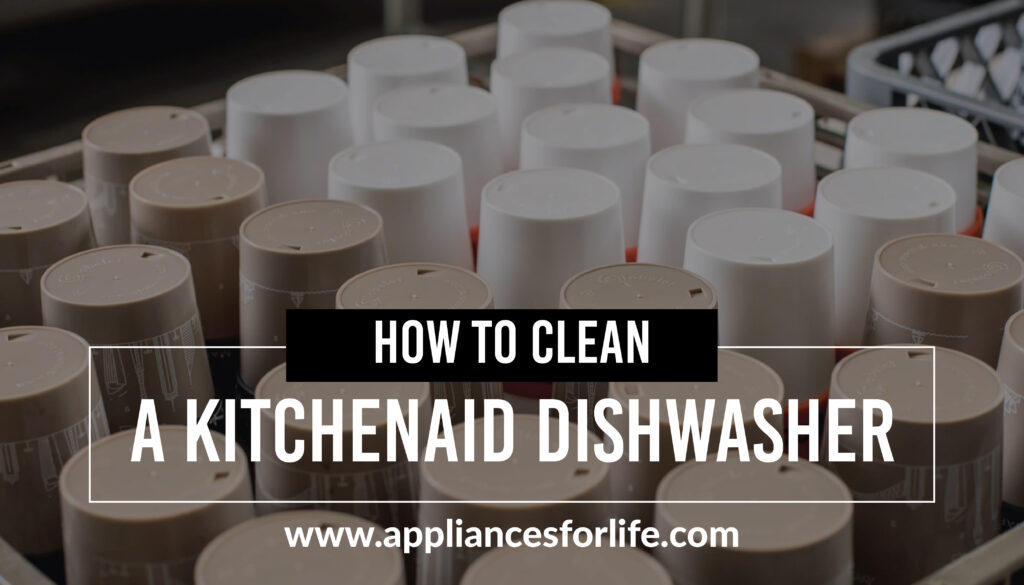- A dishwasher is indeed an indispensable Home Appliance in recent times. The hustle and bustle of the day and the stress that comes with it can no longer stand in the way of a necessary and regular dishwashing exercise, thanks to this amazing innovation. It is pertinent to note that, in order to enjoy optimal use of this invention, dish placement and position should be learned and mastered. This article provides an education on the subject.
- More importantly, the maintenance of a dishwasher through the acts of regular cleaning is crucial in order to enable it to produce desired results. Everyone wants a dishwasher that delivers clean dishes but some are not really prepared to go through the hassle of making it clean. At least it may turn out to be a struggle if the procedure for cleaning is not learned. This article helps to eradicate this concern by providing a step-by-step guide to dishwasher cleaning.
How to Load a KitchenAid Dishwasher for Cleaner Dishes
Table of Contents
ToggleLoading your KitchenAid dishwasher correctly can go a long mile to its proper functioning. Once you load your dishes inappropriately in designated dishwasher racks, you will discover that your dishes will come out cleaner. The latest model of KitchenAid dishwashers has designs that offer a third rack for cups, silverware, and small plates to minimize crowding. Learn below some peculiarities of a KitchenAid dishwasher setup and tips for use in order to realize optimal performance.
How to Load a KitchenAid Dishwasher: Rack-Specific Loading Tips
To properly load your dishwasher is to understand that each rack therein is meant for specific kinds of dishes. Placing a particular dish in the appropriate rack can help prevent overcrowding, aids in washing and drying, and avoids damage to both your dishwasher and its contents. This section will review how to utilize each rack of your KitchenAid dishwasher but before we address that, let us consider some KitchenAid pre-washing tips
Pre-Wash Tips
This guideline should be followed before you even load your dishwasher at all.
Skip the pre-rinse: Most dishwasher brands advise rinsing your dishes before you proceed to load them into the dishwasher. They say it helps get those dishes clean faster. However, the KitchenAid brand has a contrary opinion as they suggest that you skip the pre-rinse routine. This is however not to say that those large food particles, bones, and peels should be left hanging on to your plates. Get rid of large food particles and calcium but ensure to leave some grease and grime on those dishes as detergents work better on them.
Add rinse-aid: If you want water to easily flow off your dishes more easily, thereby guaranteeing drier dishes without necessarily running the ‘dry cycle’ then you may need to add some rinse-aid to your dishwasher. Do this before you begin your wash at all.
Run the garbage disposal: If you have a disposal, run it just before starting a wash cycle. This will clear its shared pipe with the dishwasher and prevent clogs and backups.
How to Load your silverware in a KitchenAid dishwasher
When you load your silverware improperly, they are prone to nesting in the silverware basket, hence they prevent water from reaching each item in the dishwasher. However, when you load your silverware properly, you would have given your spray arms full reigns to attack every food particle, grease, or grime attached to your silverware and every piece of it will then come out clean.
The positioning of your silverware in a KitchenAid dishwasher should be done in a way that forks, spoons, and knives are alternated next to each other to prevent nesting. When silverwares are nested, the reach of water supplied by the spray arms is limited and some surfaces of your silverware are obscured from the direct reach of the water. Note that when you place your forks and knives in the appropriate racks, do this carefully, placing them upside down in order to avoid cuts. If you realize that you need more space as you load your dishwasher, the silverware basket can be split into two pieces and placed anywhere on the bottom rack. You may refer to your KitchenAid dishwasher manual for instructions on how to split the basket.
Loading dishes in the Lower Rack
You may now proceed to load the lower rack as soon as you have complied with the pre-washing tips discussed above. The lower rack is designed to hold large plates, serving ware, pots, and pans. To utilize the lower rack, position the dishes facing inward to expose the inside of the plates to the dishwasher spray arms. Pots and pans should be placed upside down so that they can be within the reach of water and detergent also. The adjustable lines on the racks are so adjustable that they can be folded to accommodate larger items. Hence, when the need arises, utilize this tip. Finally, during to the lengthy nature of serving plates and cutting boards, load them along the perimeter of the rack to avoid blocking the spray arms of your dishwasher.
Note: Avoid placing plastic items and Tupperware on the lower dish rack because right beneath the lower rack is the heating element of the dishwasher. When it heats up, these items stand the risk of melting.
How to Load the Upper Dishrack
The upper rack is the section for glasses, bowls, and cups. Fragile kitchenwares are placed in this section for safer washing. the upper rack can easily accommodate plastic materials and other Tupperware and not expose them to the risk of melting.
To load a KitchenAid upper rack, place cups, bowls and glasses upside down, facing inward at the right angle to get access to water and detergent. Make sure to Secure wine glasses with plastic stemware holders. Fold these holders away for increased space when not in use. Finally, Remove the upper rack altogether to better fit taller items in the rack below.
KitchenAid Dishwasher Third Rack
New KitchenAid dishwashers have a third rack for stacking more cups, glasses, silverware, and other larger serving utensils. To properly utilize the third rack, cups, glasses, and bowls should be placed upside down at an angle that exposes them to the splash of spray arms. In the silverware tray, place one utensil per slot in the silverware tray and lastly, you may adjust the rack up or down, to accommodate any tall items.
Avoid the following mistakes when you load your KitchenAid Dishwasher
Overloading: When you overload your dishwasher, you make it very difficult to wash effectively. This is so because dishes stacked together may not have all its part touched by detergent or washing water. When there are fewer dishes, they will be easily saturated in warm water and detergent discharged by your dishwasher. More importantly, complete air circulation is more feasible with fewer dishes in your dishwasher. Hence, your dishes dry faster.
Too much or wrong detergent: If you use too much detergent or the wrong one, this may cause excessive suds and eventual streaks on your dishes. Detergent residue may even end up clogging the dishwasher itself. Hence, it is highly advisable to always advisable to apply the least recommended amount of detergent to your dishwasher.
Placing items incorrectly: Each rack in a dishwasher has its specific functions. Use each rack for the items they are designed to hold and position them properly to optimize access to water and detergent. If after all these attempts, items do not fit, you can adjust the racks by removing the removable parts.
How to Clean your KitchenAid Dishwasher
A dishwasher is arguably one of the hardest working Home Appliance that you will own. It does a decent job cleaning your dishes, glasses, silverware, pots, pans, and other essential dining materials and this is why it needs proper maintenance. Cleaning your dishwasher is one of the best ways to maintain it. Although it may sound counterintuitive to conclude that a device that gets stuff clean would need cleaning itself this is exactly why it needs to be cleaned. Think of it this way, in the process of a dishwasher’s cleaning, food particles, and other calciums do not just vanish, they find their way to the designated compartments for dirt. Hence, this suggests that those parts of the dishwasher need thorough and constant cleaning and so do other parts. Remove the upper rack altogether to better fit taller items in the rack below
Supplies for Cleaning
- Microfiber cloth or soft sponge
- Toothbrush, preferably soft too
- Warm, soapy water
STEP 1: Remove Food Residue From Dishwasher
Before loading your dishwasher again, make sure to get rid of the food particles that may be lurking in there since the last wash. Check every intricate and latent place for calcium and other food materials to keep your dishwasher in a good working condition.
STEP 2: Wipe Off Grime
Grime can build up in your dishwasher over time if a regular inspection is not carried out to eradicate it. Grime can form from mineral deposits, limescale, and grease and they can build up in a dishwasher over time affecting your dishwasher’s performance and leaving you with dirty dishes even after washing. Grime is usually found on the door of the dishwasher and it can be cleaned off by a thorough wiping with a damp cloth and a sponge. It is important to check for grease residue and wipe it away from the inside of the door, including the door’s edges and control panel. While you are at it, inspect the rubber seal that lines the door and gently clean the gasket with a soft toothbrush to remove grime from tough-to-reach crevices without putting too much pressure on the seal.
3. Remove and Clean Dishwasher Filter
With careful study of the washing process of a dishwasher, in the previous section, it is clear that water used for washing will not be completely rid of food particles and other debris if the dishwasher filter is not present. Hence the function of the filter is to basically filter out dirt, and this implies that the filter will be dirty after almost every wash. Therefore regular cleaning of the filter is necessary to prevent unnecessary dishwasher odor or unclean dishes after washing. Follow the steps below to clean your dishwasher filter;
- Locate the filter below the spray arm on the bottom of the dishwasher, then unlock and remove it.
- Wash the filter with warm, soapy water and use a soft toothbrush to get rid of any stuck-on food particles on the mesh and plastic components.
- Rinse the filter and lock it back into place.
4. Cleaning Tablets can be very handy for Deep Clean
KitchenAid tablets can go a really long way in removing build-up and cavities inside the dishwasher. They are even more useful when dealing with some latent areas of your dishwasher. They can be a very convenient cleaning solution for both stainless steel and plastic-tub dishwashers.
However, it is highly advised that you check your dishwasher manual and cleaning tablet user instructions before cleaning with tablets.
5. Wipe Down the Outside of your Dishwasher
The outside of your dishwasher may not be as instrumental as the inside of it when it comes to making your dishes come out clean. Regardless, the outside of your dishwasher should be cleaned regularly to keep it looking fresh and sleek. Wipe down the exterior of the door, all the way to the dies and the handle using a soft damp cloth and mild detergent. However, if you are dealing with a stainless exterior, you may need to procure specially-formulated stainless steel cleaners. Remember to wipe back and forth in the direction of the grain when cleaning stainless steel appliances. Avoid using abrasive cleaning products on the exterior of the dishwasher, since they can damage the finish.
How do I clean my dishwasher with Vinegar and Baking Soda?
Cleaning your KitchenAid dishwasher with Vinegar and/or baking soda can be quite a convenient alternative to KitchenAid tablets because they also do a great job getting that grime off. However, before you proceed to wipe the interior of your KitchenAid dishwasher with Vinegar, be sure to read through your KitchenAid user’s manual for clarity on the particular models that can be cleaned with Vinegar otherwise your dishwasher may be damaged, and hence need replacement.
To clean your KitchenAid dishwasher with Vinegar, do the following;
- Fill a dishwasher-safe glass with 2 cups of white vinegar and safely position it on the bottom of the dishwasher. Do not use detergent – the vinegar will mix with the wash water.
- Run the dishwasher through a complete washing cycle using an air-dry or an energy-saving dry option.
To Clean your KitchenAid Dishwasher with baking soda;
- Sprinkle a cup of baking soda along the base of the dishwasher and
- Let the dishwasher run on a short, hot water cycle.
How Do I help remove Odors and Mineral Deposits from My Dishwasher?
Cleaning your dishwasher with vinegar or a dishwasher cleaner should be part of your regular maintenance routine. However, some issues may require you to undertake a deeper cleaning routine. Hard water mineral deposits can cause damage to your dishwasher and make it almost impossible for it to achieve good cleaning. This is why a water softener is strongly advised if your water gains hardness of 15 or more.
Unwanted dishwasher smell can occur when the washer is dirty, hence it is advisable that you follow the steps discussed above for proper cleaning. On the other hand, dishwasher smells may also stem from its new plastic components. If this is the case, make sure to run a rinse cycle for the washer before use.
FAQs
Are there items I should not place in my dishwasher?
Yes. A good rule of thumb is to leave out wood, iron, aluminum, crystal, and any china not labeled dishwasher-safe. Hand washing is a great choice for those items, as they can be permanently discolored or damaged in the dishwasher. Hence, it is important to know what to put and not put in a dishwasher
Is there a correct way to load my Dishwasher?
Dishwashers are built with racks for specific kinds of dishes. The top rack is usually left for glasses, cups, and bowls that may be endangered by the heating of the dishwasher element at the base of the base. The lower rack stacks the larger kitchenware like pots, spoons, and pans. KitchenAid dishwashers are built with a third rack also for cups, glasses, etc.
How do dishwashers work?
Dishwashers use a pressurized spray method. Water is discharged from spraying arms unto dishes and food particles are taken off conveniently.
24 MINUTES
ESTIMATED TIME DESIGNING AND UPLOADING THIS ARTICLE
10 HOURS 26 MINUTES
ESTIMATED TIME RESEARCHING AND WRITING THIS ARTICLE
You Might Also Like

The XO pizza oven comes with the patented Air Plus system that boasts of achieving cooking temperatures with less fuel in 15 to 20 minutes. The oven’s electro-galvanized, powder-coated roof holds up well to extreme weather and is resistant to scratches, abrasions, and chips. The

It’s hard to imagine a modern kitchen without a microwave oven. The microwave is now one of the most important kitchen appliances, maybe only behind the refrigerator and cooking range. We understand how it might be to get your hands on an affordable microwave, especially

How To Clean a GE Profile Ice Maker?
Whether people like it or not, the ice maker brings a different and unique way of icemaking into every modern household that has it. Cleaning GE Profile ice makers is seen as a big deal by many, but this article will put you through how

How to Use a Stovetop Milk Steamer?
Having your milk steamed before consuming it is very healthy. Our stove milk steamer instructions will help guide you through how to use a stovetop milk steamer. Milk is one of the healthiest things you can take because it’s packed with enough nutrients. In this

Top 9 Best Fruits to Juice You will Love to Know.
Our team has done a lot of research into good fruits and vegetables to juice as well as which juicers to buy. Today we are going into detail about the best fruits to juice, why and why they are so healthy for your body. Throughout

Best Quiet Blenders for Smoothies
Best Quiet Blenders 01. Ninja BL660 Professional Countertop Blender with 1100-watt Base Brand: Ninja Editor’s Rating 5/5 Click Here to Check Price on Amazon 02. Ninja Foodi SS201 Power Blender & Food Processor Brand: Ninja Editor’s Rating 4.5/5 Click Here to Check Price

Best Blender For Hummus And You
Jumping In The Mix Looking for the best blender for hummus can be a challenge made simple with some easy guidelines and tips. Some say that ‘proper’ hummus must be concocted in a food processor but more and more chefs – yes, culinary experts –

Can You Use a Ninja Blender as a Food Processor?
A popular question amongst those who own Ninja blenders today is “Can you use a Ninja blender as a food processor?” If you’ve found yourself trying to find an answer to that question, we’re here to help. Ninja blenders are very famous for being versatile,

The Best Tea Kettles Suited For Induction Cooktops
Every season is great for a cup of tea whether it is summer for fruit tea, autumn for herbal tea, winter for mint tea or spring for English tea. Don’t you just love that feeling settling in the armchair with a good book, watching the

Review: Ninja Foodi Blender 1400 Watts
Our Ninja Foodi Hot and Cold blender review will tell you everything you need to know about the Ninja Professional Plus Blender 1400 watts. Generally, purchasing appliances can be daunting, so when it gets to the point where people get to make a decision, they

